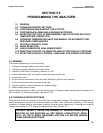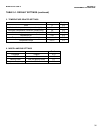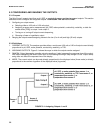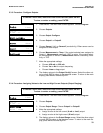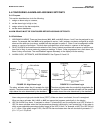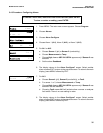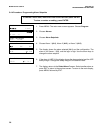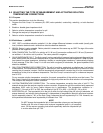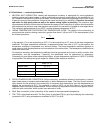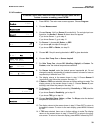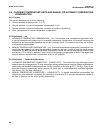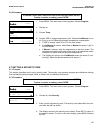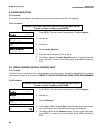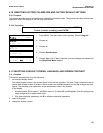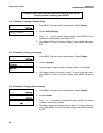
37
MODEL SOLU COMP II SECTION 5.0
PROGRAMMING THE ANALYZER
5.5 SELECTING THE TYPE OF MEASUREMENT AND ACTIVATING SOLUTION
TEMPERATURE CORRECTIONS
5.5.1 Purpose
This section describes how to do the following:
1. Program the Solu Comp II to measure pH, ORP, redox potential, conductivity, resistivity, or total dissolved
solids.
2. Enable or disable glass impedance fault.
3. Select a solution temperature correction for pH.
4. Change the analyzer pH isopotential point.
5. Select a solution temperature correction for conductivity.
5.5.2 Definitions — pH/ORP
1. ORP. ORP is oxidation-reduction potential. It is the voltage difference between a noble metal (usually plat-
inum) indicator electrode and a silver/silver chloride reference electrode.
2. REDOX. Redox is redox potential. Redox potential is measured the same way as ORP. The sign of the redox
potential is the negative of ORP.
3. SIGN CONVENTION. The ORP of a solution of 0.1 M iron (II) ammonium sulfate and 0.1 M iron (III) ammoni-
um sulfate in 1 M sulfuric acid is positive. The redox potential is negative.
4. GLASS IMPEDANCE FAULT. The Solu comp II can be used with pH sensors having advanced diagnostic fea-
tures, which permit the continuous determination of glass and reference electrode impedance. When the ana-
lyzer detects low glass impedance, indicating a broken or cracked glass membrane, it automatically displays
a fault message. If the Solu Comp II is to be used with non-glass pH electrodes, the glass impedance fault
should be disabled.
5. SOLUTION TEMPERATURE CORRECTION. The pH of a solution, particularly an alkaline one, is a function
of temperature. If the temperature changes, so does the pH, even though the concentration of the acid or base
causing the pH remains constant. Solution temperature compensation converts the pH at the measurement
temperature to the pH at a reference temperature. The Solu Comp II corrects the pH to a reference tempera-
ture of 25°C.
For an accurate solution temperature correction, the exact composition of the solution must be known. The
Solu Comp II has built-in temperature corrections for high purity water and for dilute solutions of a strong base.
The analyzer also accepts a custom correction.
6. CUSTOM TEMPERATURE CORRECTION. The custom temperature correction has units of ∆pH/°C. The
example shows how the analyzer uses the custom correction. Suppose the pH of the solution being measured
decreases 0.022 units for every Celsius degree rise in temperature. The temperature correction is -
0.022pH/°C. If the pH at 20°C is 8.95, the corrected pH (at 25°C) is 8.95 + (-0.022)(25 - 20) or 8.84.
7. ISOPOTENTIAL pH. The isopotential pH is the pH at which the cell voltage (the cell is the pH electrode, ref-
erence electrode, and solution being measured) is independent of temperature. Most pH cells have isopoten-
tial pH reasonably close to 7.00, so the Solu Comp II assumes the cell isopotential pH is 7.00. However, cer-
tain specialized electrodes have isopotential pH different from 7.00.
NOTE
Do NOT change the isopotential pH of the transmitter unless you are thoroughly
familiar with the role of sensor and analyzer isopotential point in pH measure-
ment, OR the sensor operating instructions specifically state the isopotential pH
is a value other than pH 7.00.



